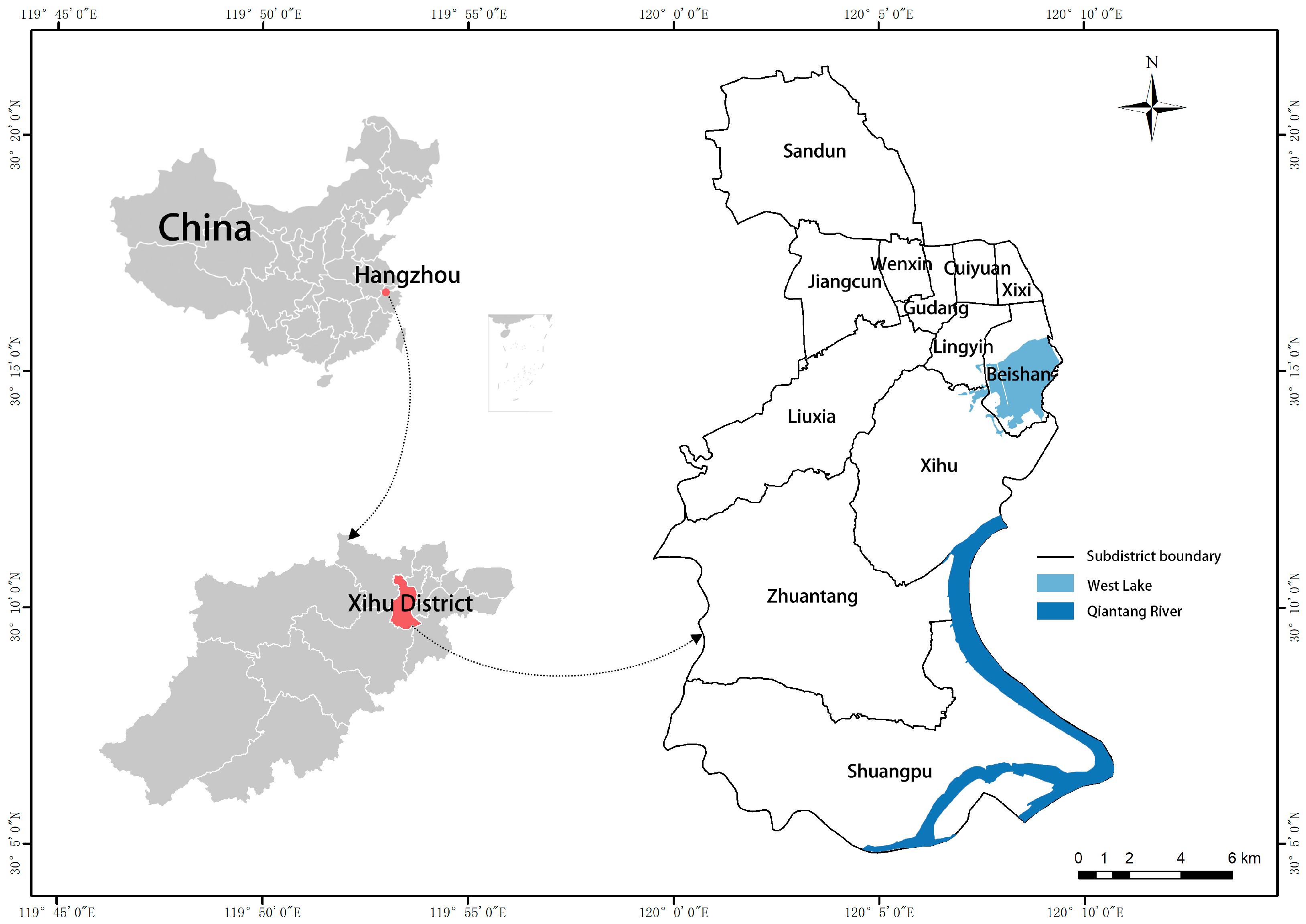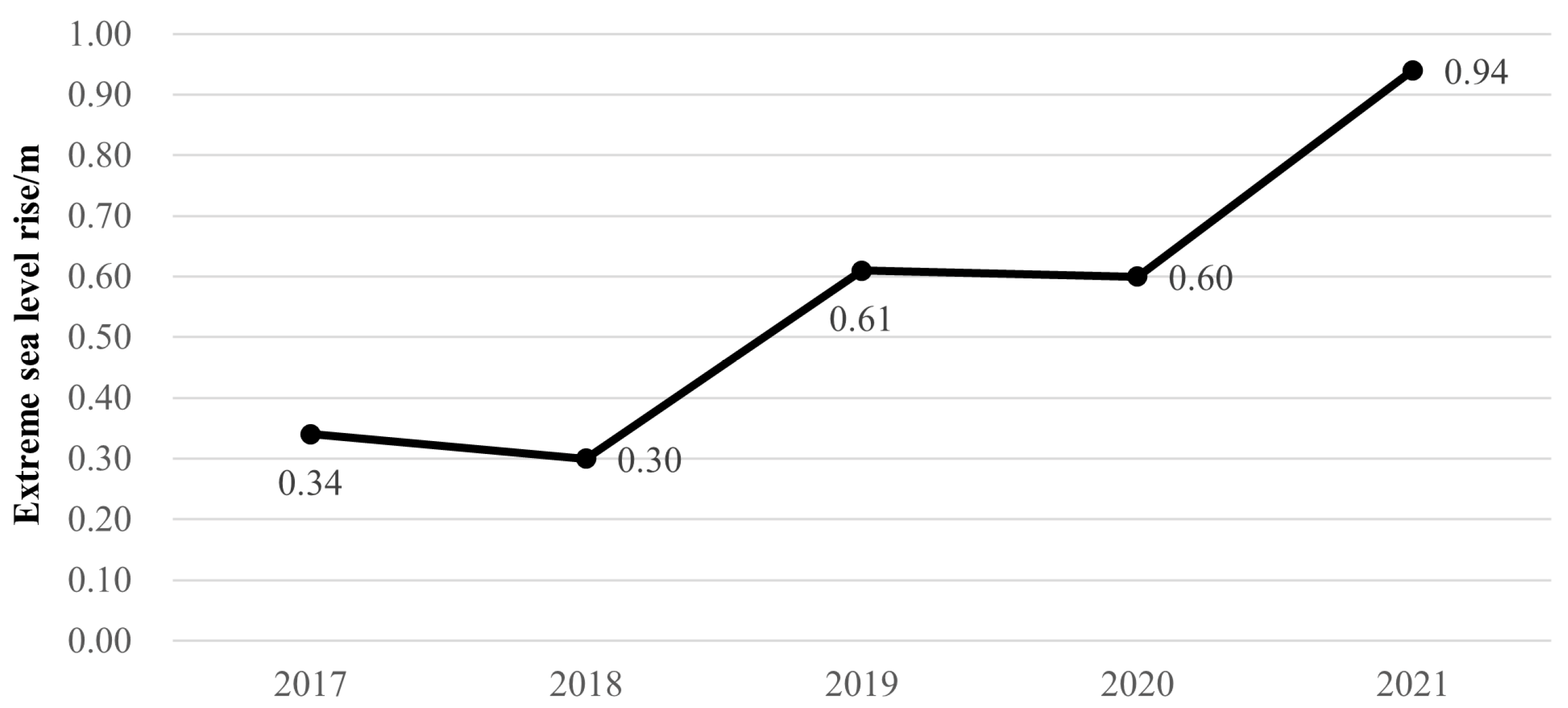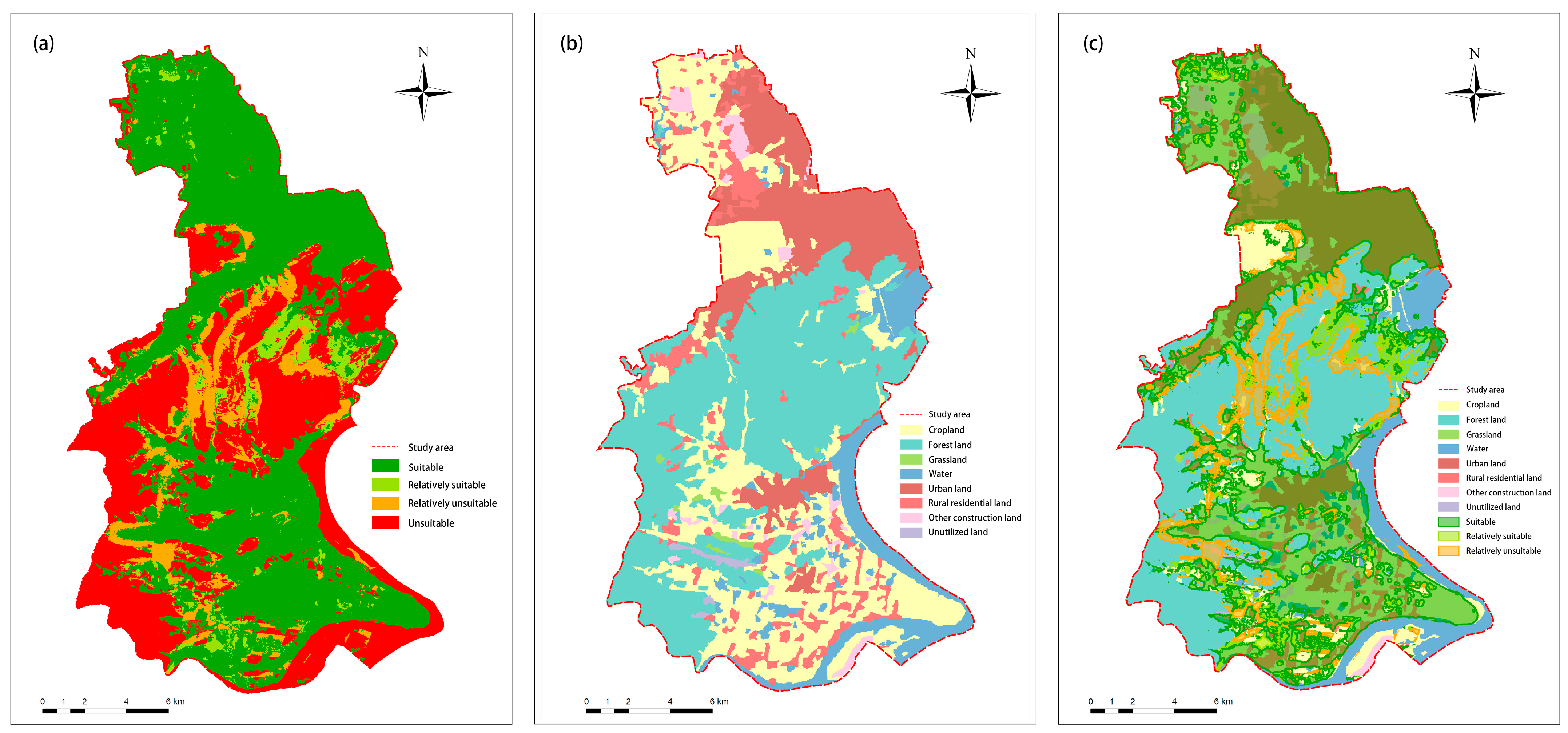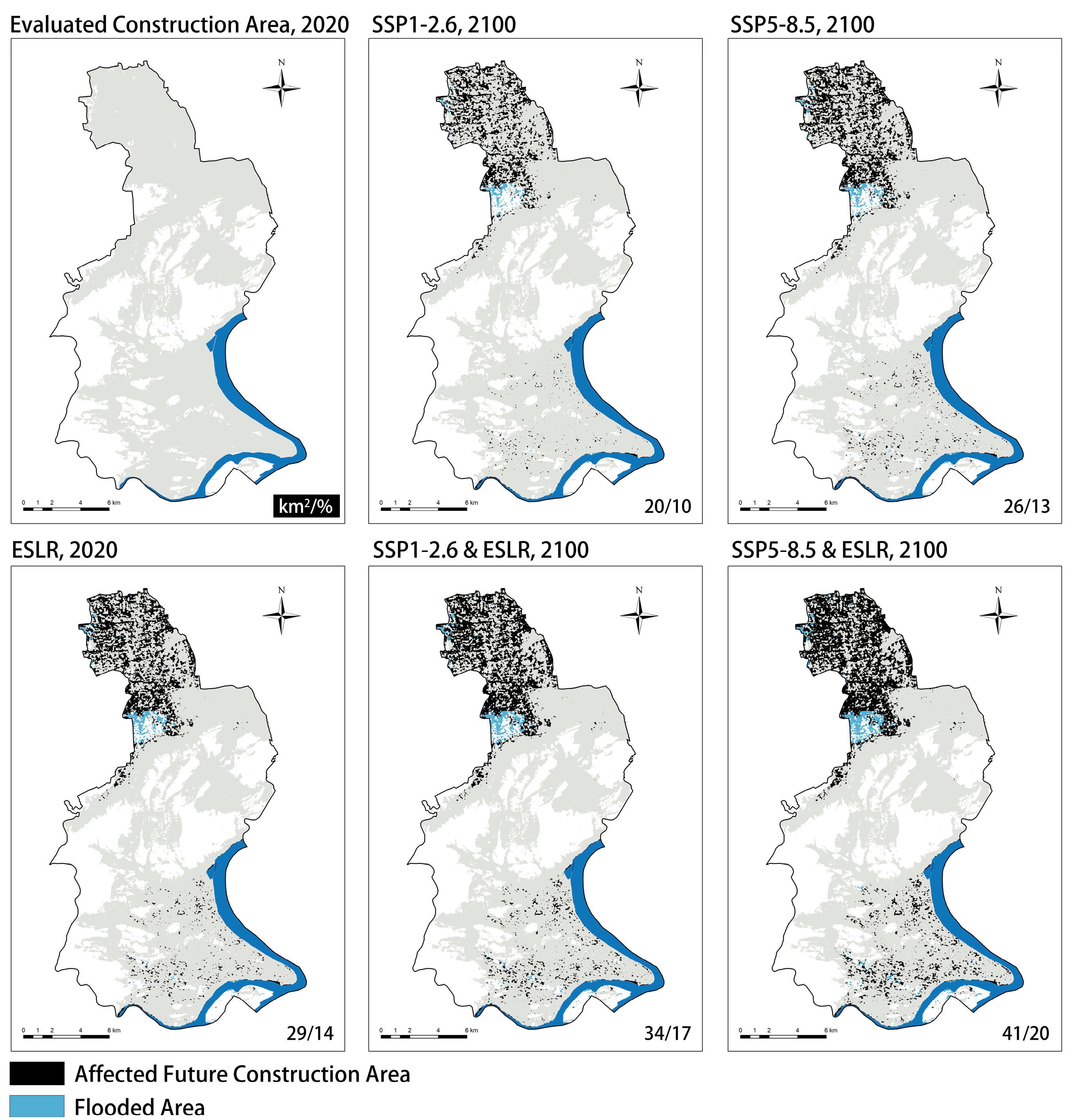Evaluation of Urban Land Suitability under Multiple Sea Level Rise Scenarios
Abstract
:1. Introduction
2. Materials and Methods
2.1. Study Area
2.2. Data Acquisition
2.3. Methods
2.3.1. Establishment of the Evaluation System
- (1)
- Indicator Selection
- (2)
- Evaluation Grades and Criteria
- (3)
- Determination of Weights Based on Entropy Method
2.3.2. Construction of the Evaluation Model Based on Matter-Element Theory
- (1)
- Determination of classical domain and nodal domain.
- (2)
- Determination of Matter elements to Be Evaluated
- (3)
- Calculation of Correlation Between Each Indicator and Evaluation Grade
- (4)
- Calculation of Integrated Correlation Degree
2.3.3. Analysis of Sea Level Rise under Climate Change Scenarios
3. Results
3.1. Suitability Analysis of Urban Land
3.1.1. Spatial Distribution and Statistics of Land Suitability
3.1.2. Validation of Rationality Compared with Planned Land Use
3.1.3. Distribution of Land Suitability Grade Values
3.2. Multi-Scenario Analysis of Sea Level Rise under Climate Change
4. Discussion
4.1. Optimization of Methods for Land Suitability Evaluation
4.2. Recommendations for Urban Land Development Based on Suitability Evaluation
4.3. Spatial Planning Strategies Analyzing Flood Risk
5. Conclusions
Author Contributions
Funding
Institutional Review Board Statement
Informed Consent Statement
Data Availability Statement
Conflicts of Interest
References
- Xie, H.; Zhang, Y.; Duan, K. Evolutionary Overview of Urban Expansion Based on Bibliometric Analysis in Web of Science from 1990 to 2019. Habitat Int. 2020, 95, 102100. [Google Scholar] [CrossRef]
- Ustaoglu, E.; Aydinoglu, A.C. Suitability Evaluation of Urban Construction Land in Pendik District of Istanbul, Turkey. Land Use Pol. 2020, 99, 104783. [Google Scholar] [CrossRef]
- Li, Q.; Huang, J.; Wang, C.; Lin, H.; Zhang, J.; Jiang, J.; Wang, B. Land Development Suitability Evaluation of Pingtan Island Based on Scenario Analysis and Landscape Ecological Quality Evaluation. Sustainability 2017, 9, 1292. [Google Scholar] [CrossRef]
- Malczewski, J. GIS-Based Land-Use Suitability Analysis: A Critical Overview. Prog. Plan. 2004, 62, 3–65. [Google Scholar] [CrossRef]
- IPCC. Summary for Policymakers. In Climate Change and Land: IPCC Special Report on Climate Change, Desertification, Land Degradation, Sustainable Land Management, Food Security, and Greenhouse Gas Fluxes in Terrestrial Ecosystems; Cambridge University Press: Cambridge, UK; New York, NY, USA, 2022; pp. 1–36. [Google Scholar] [CrossRef]
- IPCC. Summary for Policymakers. In Global Warming of 1.5 °C. An IPCC Special Report on the Impacts of Global Warming of 1.5 °C above Pre-Industrial Levels and Related Global Greenhouse Gas Emission Pathways, in the Context of Strengthening the Global Response to the Threat of Climate Change, Sustainable Development, and Efforts to Eradicate Poverty; Cambridge University Press: Cambridge, UK; New York, NY, USA, 2018; pp. 3–24. [Google Scholar] [CrossRef]
- Fox-Kemper, B.; Hewitt, H.T.; Xiao, C.; Aðalgeirsdóttir, S.S.; Drijfhout, T.L.; Edwards, N.R.; Golledge, M.; Hemer, R.E.; Kopp, G.; Krinner, A.; et al. Ocean, Cryosphere and Sea Level Change. In Climate Change 2021: The Physical Science Basis. Contribution of Working Group I to the Sixth Assessment Report of the Intergovernmental Panel on Climate Change; Cambridge University Press: Cambridge, UK; New York, NY, USA, 2021; pp. 1211–1362. [Google Scholar] [CrossRef]
- Qing, J.; Wang, Z.; Zhang, Z. Suitability Assessment of Tobacco-Planted Land Based on RBF (Radial Basis Function) Neural Network. J. Southwest Univ. 2008, 30, 122–127. [Google Scholar]
- Fang, X. The Research on Suitability Assessment of Construction Land in Hang Zhou. Master’s Thesis, China University of Geosciences, Wuhan, China, 2008. [Google Scholar]
- Xu, K.; Kong, C.; Li, J.; Zhang, L. GEO-Environmental Suitability Evaluation of Land for Urban Construction Based on A Back-Propagation Neural Network and GIS: A Case Study of Hangzhou. Phys. Geogr. 2012, 33, 457–472. [Google Scholar] [CrossRef]
- Kang, Z.; Wang, S.; Xu, L.; Yang, F.; Zhang, S. Suitability Assessment of Urban Land Use in Dalian, China Using PNN and GIS. Nat. Hazards 2021, 106, 913–936. [Google Scholar] [CrossRef]
- Chen, Y.; Yu, J.; Khan, S. Spatial sensitivity analysis of multi-criteria weights in GIS-based land suitability evaluation. Environ. Modell. Softw. 2010, 25, 1582–1591. [Google Scholar] [CrossRef]
- Zhao, X. Evaluation on Suitability of Cultivated Land Suitability Based on Weights Sensitivity for Analysis Hunan Province. Master’s Thesis, Henan University, Zhengzhou, China, 2014. [Google Scholar]
- Ding, Y. Ecological Suitability Evaluation of Urban Construction Land Based on ANP-GIS Coupling Model—A Case Study of Changchun City. Master’s Thesis, Jilin University, Changchun, China, 2018. [Google Scholar]
- Montgomery, B.; Dragićević, S.; Dujmović, J. Using Soft Computing Logic and the Logic Scoring of Preference Method for Agricultural Land Suitability Evaluation. In Advances in Geocomputation, 13th International Conference on Geocomputation (Geocomputation), Univ Texas Dallas, Dallas, TX, USA, 20–23 May 2015; Griffith, D.A., Chun, Y., Dean, D.J., Eds.; Springer International Publishing: Cham, Switzerland, 2017; pp. 217–227. [Google Scholar]
- Dragićević, S.; Dujmović, J.; Minardi, R. Modeling Urban Land-Use Suitability with Soft Computing: The GIS-LSP Method. In GeoComputational Analysis and Modeling of Regional Systems; Thill, J.-C., Dragicevic, S., Eds.; Advances in Geographic Information Science; Springer International Publishing: Cham, Switzerland, 2018; pp. 257–275. ISBN 978-3-319-59511-5. [Google Scholar]
- Jiang, H.; Eastman, J.R. Application of Fuzzy Measures in Multi-Criteria Evaluation in GIS. Int. J. Geogr. Inf. Sci. 2000, 14, 173–184. [Google Scholar] [CrossRef]
- Mokarram, M.; Mirsoleimani, A. Using Fuzzy-AHP and Order Weight Average (OWA) Methods for Land Suitability Determination for Citrus Cultivation in ArcGIS (Case Study: Fars Province, Iran). Phys. A Stat. Mech. Its Appl. 2018, 508, 506–518. [Google Scholar] [CrossRef]
- Burrough, P.A.; McDonnell, R.A. Principles of Geographical Information Systems; Oxford University Press: Oxford, UK, 1998. [Google Scholar]
- Chen, S.; Chai, C.; Su, Y. Variable fuzzy sets methods and application on land suitability evaluation. Trans. Chin. Soc. Agric. Eng. 2007, 3, 95–97. [Google Scholar]
- Qiu, F.; Chastain, B.; Zhou, Y.; Zhang, C.; Sridharan, H. Modeling Land Suitability/Capability Using Fuzzy Evaluation. GeoJournal 2014, 79, 167–182. [Google Scholar] [CrossRef]
- Li, X.; Wang, J.; Shao, X. Progress in the Application of Fuzzy Mathematics Methods in China Land Resource Evaluation. Prog. Geogr. 2009, 28, 409–416. [Google Scholar]
- Alexander, S.M.; Waters, N.M.; Paquet, P.C. A Probability-Based GIS Model for Identifying Focal Species Linkage Zones across Highways in the Canadian Rocky Mountains. In Applied GIS and Spatial Analysis; John Wiley & Sons, Ltd.: Hoboken, NJ, USA, 2003; pp. 233–255. ISBN 978-0-470-87133-1. [Google Scholar]
- Lv, L. Land Suitability Assessment Model Based on Weights of Evidence Method and Its Application—A Case Study of Jinan, China. Ph.D. Dissertation, China University of Geosciences, Beijing, China, 2013. [Google Scholar]
- Jin, G.; Wang, Z.; Hu, X.; Hu, S.; Zhang, D. Land suitability evaluation in Qinghai-Tibet Plateau based on fuzzy weight of evidence model. Trans. Chin. Soc. Agric. Eng. 2013, 29, 241–250. [Google Scholar]
- Rossiter, D.G. ALES: A Framework for Land Evaluation Using a Microcomputer. Soil Use Manag. 1990, 6, 7–20. [Google Scholar] [CrossRef]
- Wu, T.; Dong, W.; Luo, J.; Sun, Y.; Huang, Q.; Wu, W.; Hu, X. Geo-Parcel-Based Geographical Thematic Mapping Using C5.0 Decision Tree: A Case Study of Evaluating Sugarcane Planting Suitability. Earth Sci. Inf. 2019, 12, 57–70. [Google Scholar] [CrossRef]
- Wang, S.; Liu, Y.; Wang, X.; Wu, C. Suitability evaluation of mining-land reclamation based on improved decision tree model. Sci. Soil Water Conserv. 2016, 14, 35–43. [Google Scholar] [CrossRef]
- Zhang, H.; Guo, Y.; Gao, B. Multi-model Suitability Assessment of Construction Land in Tsinling Mountains Based on the Niche Theory: A Case Study of Shangzhou, Shangluo. Geogr. Geo-Inf. Sci. 2016, 32, 83–89. [Google Scholar]
- Su, H.; Chen, J. The Application of Matter Element Analysis in Land Suitability Evaluation. J. Qufu Norm. Univ. 2005, 31, 115–119. [Google Scholar]
- Wei, H. Matter-element Extension Method and Empirical Study on Land Suitability Evaluation. Master’s Thesis, Guangxi University, Nanning, China, 2006. [Google Scholar]
- Gong, J.; Liu, Y.; Chen, W. Land Suitability Evaluation for Development Using a Matter-Element Model: A Case Study in Zengcheng, Guangzhou, China. Land Use Policy 2012, 29, 464–472. [Google Scholar] [CrossRef]
- Heumann, B.W.; Walsh, S.J.; McDaniel, P.M. Assessing the Application of a Geographic Presence-Only Model for Land Suitability Mapping. Ecol. Inform. 2011, 6, 257–269. [Google Scholar] [CrossRef] [PubMed]
- Seyedmohammadi, J.; Sarmadian, F.; Jafarzadeh, A.A.; McDowell, R.W. Development of a model using matter element, AHP and GIS techniques to assess the suitability of land for agriculture. Geoderma 2019, 352, 80–95. [Google Scholar] [CrossRef]
- Reckien, D.; Salvia, M.; Heidrich, O.; Church, J.M.; Pietrapertosa, F.; De Gregorio-Hurtado, S.; D’Alonzo, V.; Foley, A.; Simoes, S.G.; Krkoška Lorencová, E.; et al. How Are Cities Planning to Respond to Climate Change? Assessment of Local Climate Plans from 885 Cities in the EU-28. J. Clean. Prod. 2018, 191, 207–219. [Google Scholar] [CrossRef]
- Greiving, S.; Fleischhauer, M. National Climate Change Adaptation Strategies of European States from a Spatial Planning and Development Perspective. Eur. Plan. Stud. 2012, 20, 27–48. [Google Scholar] [CrossRef]
- Macintosh, A.; Foerster, A.; McDonald, J. Policy Design, Spatial Planning and Climate Change Adaptation: A Case Study from Australia. J. Environ. Plan. Manag. 2015, 58, 1432–1453. [Google Scholar] [CrossRef]
- Yiannakou, A.; Salata, K.-D. Adaptation to Climate Change through Spatial Planning in Compact Urban Areas: A Case Study in the City of Thessaloniki. Sustainability 2017, 9, 271. [Google Scholar] [CrossRef]
- Leibowicz, B.D. Urban Land Use and Transportation Planning for Climate Change Mitigation: A Theoretical Framework. Eur. J. Oper. Res. 2020, 284, 604–616. [Google Scholar] [CrossRef]
- Andrzejewska, A.K. Challenges of Spatial Planning in Poland in the Context of Global Climate Change—Selected Issues. Buildings 2021, 11, 596. [Google Scholar] [CrossRef]
- Demuzere, M.; Orru, K.; Heidrich, O.; Olazabal, E.; Geneletti, D.; Orru, H.; Bhave, A.G.; Mittal, N.; Feliu, E.; Faehnle, M. Mitigating and Adapting to Climate Change: Multi-Functional and Multi-Scale Assessment of Green Urban Infrastructure. J. Environ. Manag. 2014, 146, 107–115. [Google Scholar] [CrossRef]
- Kabisch, N.; Frantzeskaki, N.; Pauleit, S.; Naumann, S.; Davis, M.; Artmann, M.; Haase, D.; Knapp, S.; Korn, H.; Stadler, J.; et al. Nature-Based Solutions to Climate Change Mitigation and Adaptation in Urban Areas: Perspectives on Indicators, Knowledge Gaps, Barriers, and Opportunities for Action. Ecol. Soc. 2016, 21, 39. [Google Scholar] [CrossRef]
- Sharifi, A. Co-Benefits and Synergies between Urban Climate Change Mitigation and Adaptation Measures: A Literature Review. Sci. Total Environ. 2021, 750, 141642. [Google Scholar] [CrossRef] [PubMed]
- Gurran, N.; Hamin Infield, E.; Norman, B. Planning for Climate Change: Leading Practice Principles and Models for Sea Change Communities in Coastal Australia; Faculty of Architecture, University of Sydney: Sydney, Australia, 2008. [Google Scholar]
- Francesch-Huidobro, M.; Dabrowski, M.; Tai, Y.; Chan, F.; Stead, D. Governance Challenges of Flood-Prone Delta Cities: Integrating Flood Risk Management and Climate Change in Spatial Planning. Prog. Plan. 2017, 114, 1–27. [Google Scholar] [CrossRef]
- IPCC. Summary for Policymakers. In IPCC Special Report on the Ocean and Cryosphere in a Changing Climate; Cambridge University Press: Cambridge, UK; New York, NY, USA, 2019; pp. 3–35. [Google Scholar] [CrossRef]
- Liu, Z.; Yang, Y.; He, C.; Tu, M. Climate change will constrain the rapid urban expansion in drylands: A scenario analysis with the zoned land use scenario dynamics-urban model. Sci. Total Environ. 2019, 651, 2772–2786. [Google Scholar] [CrossRef] [PubMed]
- Chen, G.; Xie, J.; Li, W.; Li, X.; Chung, L.C.H.; Ren, C.; Liu, X. Future “Local Climate Zone” Spatial Change Simulation in Greater Bay Area under the Shared Socioeconomic Pathways and Ecological Control Line. Build. Environ. 2021, 203, 108077. [Google Scholar] [CrossRef]
- Li, S.; Juhász-Horváth, L.; Pedde, S.; Pintér, L.; Rounsevell, M.D.A.; Harrison, P.A. Integrated Modelling of Urban Spatial Development under Uncertain Climate Futures: A Case Study in Hungary. Environ. Model. Softw. 2017, 96, 251–264. [Google Scholar] [CrossRef]
- Yue, Y.; Zhang, P.; Shang, Y. The Potential Global Distribution and Dynamics of Wheat under Multiple Climate Change Scenarios. Sci. Total Environ. 2019, 688, 1308–1318. [Google Scholar] [CrossRef] [PubMed]
- Hung, C.-L.J.; James, L.A.; Carbone, G.J.; Williams, J.M. Impacts of Combined Land-Use and Climate Change on Streamflow in Two Nested Catchments in the Southeastern United States. Ecol. Eng. 2020, 143, 105665. [Google Scholar] [CrossRef]
- Huang, J.; Tang, Z.; Liu, D.; He, J. Ecological Response to Urban Development in a Changing Socio-Economic and Climate Context: Policy Implications for Balancing Regional Development and Habitat Conservation. Land Use Policy 2020, 97, 104772. [Google Scholar] [CrossRef]
- Lv, H.; Guan, X.; Meng, Y. Comprehensive Evaluation of Urban Flood-Bearing Risks Based on Combined Compound Fuzzy Matter-Element and Entropy Weight Model. Nat. Hazards 2020, 103, 1823–1841. [Google Scholar] [CrossRef]
- Avashia, V.; Garg, A. Implications of Land Use Transitions and Climate Change on Local Flooding in Urban Areas: An Assessment of 42 Indian Cities. Land Use Pol. 2020, 95, 104571. [Google Scholar] [CrossRef]
- Muis, S.; Güneralp, B.; Jongman, B.; Aerts, J.C.J.H.; Ward, P.J. Flood Risk and Adaptation Strategies under Climate Change and Urban Expansion: A Probabilistic Analysis Using Global Data. Sci. Total Environ. 2015, 538, 445–457. [Google Scholar] [CrossRef] [PubMed]
- Wei, F.; Zhao, L. The Effect of Flood Risk on Residential Land Prices. Land 2022, 11, 1612. [Google Scholar] [CrossRef]
- Annual Damage Statistics of Natural Disasters in Zhejiang Province. Available online: http://www.rencity.zju.edu.cn/zhejiangDisasterLoss/#FloodSec-eco (accessed on 3 April 2024).
- Lee, J.-Y.; Marotzke, J.; Bala, G.; Cao, L.; Corti, S.; Dunne, J.P.; Engelbrecht, F.; Fischer, E.; Fyfe, J.C.; Jones, C.; et al. Future Global Climate: Scenario-Based Projections and NearTerm Information. In Climate Change 2021: The Physical Science Basis. Contribution of Working Group I to the Sixth Assessment Report of the Intergovernmental Panel on Climate Change; Cambridge University Press: Cambridge, UK; New York, NY, USA, 2021; pp. 553–672. [Google Scholar] [CrossRef]
- Zong, Y.; Wang, R.; Wang, C.; Wang, H.; Zhang, L. Ecological suitability assessment on land use based on potential-constrain approach: The case of urbanized areas in Dalian city, China. Geogr. Res. 2007, 26, 1117–1126+1305. [Google Scholar]
- Luo, X.; Zhou, X.; Yang, J.; Jiang, X.; Zhang, J.; Li, H. Suitability evaluation of land and space development and construction in central Guizhou Economic Zone based on different development situations. Ecol. Sci. 2021, 40, 211–221. [Google Scholar] [CrossRef]
- Zhao, H.; Chen, C. A Positive Study of Urban Construction Suitability Evaluation Based on FLUS Model, Foshan. Planners 2020, 36, 86–92. [Google Scholar]
- Nong, X.; Wu, B.; Chen, T.; Chen, L. Evaluation of National Land Use and Space for Functions of “Production, Life, Ecology”, Liuzhou. Planners 2020, 36, 26–32. [Google Scholar]
- Hoque, I.; Rohatgi, S. Identification of Potential Urban Residential Area by Integrating AHP and WCL in RS and GIS Environment: A Case Study of Siliguri Municipal Corporation and Its Buffer of 7 Km, West Bengal. J. Indian Soc. Remote Sens. 2022, 50, 1437–1456. [Google Scholar] [CrossRef]
- Li, W.; Li, P.; Feng, Z.; Xiao, C. GIS-Based Modeling of Human Settlement Suitability for the Belt and Road Regions. Int. J. Environ. Res. Public Health 2022, 19, 6044. [Google Scholar] [CrossRef] [PubMed]
- Cai, W. Matter-Element Model and Its Application; Science and Technology Literature Press: Beijing, China, 1994. [Google Scholar]
- Cai, W. Extension theory and its application. Chin. Sci. Bull. 1999, 44, 673–682. [Google Scholar] [CrossRef]
- Storch, H.; Downes, N.K. A Scenario-Based Approach to Assess Ho Chi Minh City’s Urban Development Strategies against the Impact of Climate Change. Cities 2011, 28, 517–526. [Google Scholar] [CrossRef]
- Alves, A.; Gersonius, B.; Kapelan, Z.; Vojinovic, Z.; Sanchez, A. Assessing the Co-Benefits of Green-Blue-Grey Infrastructure for Sustainable Urban Flood Risk Management. J. Environ. Manag. 2019, 239, 244–254. [Google Scholar] [CrossRef] [PubMed]
- Chen, W.; Wang, W.; Huang, G.; Wang, Z.; Lai, C.; Yang, Z. The Capacity of Grey Infrastructure in Urban Flood Management: A Comprehensive Analysis of Grey Infrastructure and the Green-Grey Approach. Int. J. Disaster Risk Reduct. 2021, 54, 102045. [Google Scholar] [CrossRef]
- Yang, N. Study on the Land Suitability Evaluation of Small Watershed on Rainfall Flood Safety in Changsha Su Yu Embankment. Master’s Thesis, Hunan University, Changsha, China, 2015. [Google Scholar]
- Apud, A.; Faggian, R.; Sposito, V.; Martino, D. Suitability Analysis and Planning of Green Infrastructure in Montevideo, Uruguay. Sustainability 2020, 12, 9683. [Google Scholar] [CrossRef]
- Jones, S.; Somper, C. The Role of Green Infrastructure in Climate Change Adaptation in London. Geogr. J. 2014, 180, 191–196. [Google Scholar] [CrossRef]






| Perspectives of Indicator Selection | Types | Indicators |
|---|---|---|
| Geographic Resource Conditions | Topography | Slope, elevation, topographic relief |
| Natural Resources | Vegetation coverage, total water resources, available water resource potential, water sources, ecological reserves | |
| Natural Disasters | Landslides and debris flows, geological hazard susceptibility, ecosystem vulnerability, seismic hazard | |
| Climate Environment | Water area proportion, distance from water, temperature humidity index | |
| Economic Location Conditions | Traffic Location | Distance from built-up areas, distance from major traffic arteries, traffic network density, accessibility of transportation arteries, accessibility of transportation hubs, accessibility of central city |
| Socioeconomic | Economic level, land use, population density, scale of existing developed urban areas, land cover index |
| Evaluation Grades | Suitable | Relatively Suitable | Relatively Unsuitable | Unsuitable |
|---|---|---|---|---|
| Slope (°) | <6 | 6–15 | 15–25 | >25 |
| Elevation (m) | <52 | 52–136 | 136–247 | >247 |
| Topographic relief (m) | <50 | 50–100 | 100–200 | >200 |
| Temperature humidity index | 24.6–25.4 | 25.4–25.7 | 25.7–25.9 | 25.9–26.3 |
| Distance from rivers (km) | 0–1.17 | 1.17–2.96 | 2.96–5.15 | 5.15–8.76 |
| Susceptibility to geological disasters | Unsusceptible | Relatively unsusceptible | Relatively susceptible | Susceptible |
| Land cover | Built area, Bare ground | Cropland | Flooded vegetation, Rangeland | Water, Forest land |
| Accessibility of traffic arteries | 8.8–13.2 | 13.2–17.3 | 17.3–21.6 | 21.6–28.7 |
| Accessibility of traffic hubs | 9.0–13.8 | 13.8–16.6 | 16.6–19.8 | 19.8–26.7 |
| Road network density (km/km2) | 1.62–3.25 | 1.04–1.62 | 0.42–1.04 | 0–0.42 |
| Perspectives of Selection | Categories of Factors | Indicators | Weights |
|---|---|---|---|
| Natural Resource Environment (constraint factor) | Topography | . Slope | 0.059 |
| . Elevation | 0.062 | ||
| . Topographic relief | 0.073 | ||
| Climate environment | . Temperature humidity index | 0.134 | |
| . Distance from rivers | 0.035 | ||
| Disaster risk | . Susceptibility to geological disasters | 0.047 | |
| Economic Location Conditions (potential factor) | Land cover | . Land cover | 0.262 |
| Location condition | . Accessibility of traffic arteries | 0.057 | |
| . Accessibility of traffic hubs | 0.038 | ||
| Traffic network density | . Road network density | 0.233 |
| Indicators | Suitable | Relatively Suitable | Relatively Unsuitable | Unsuitable |
|---|---|---|---|---|
| Slope | 0.31 | −0.31 | −0.72 | −0.83 |
| Elevation | 0.10 | −0.90 | −0.96 | −0.98 |
| Topographic relief | 0.27 | −0.73 | −0.88 | −0.92 |
| Temperature humidity index | −0.10 | 0.32 | −0.19 | −0.36 |
| Distance from rivers | −0.19 | 0.20 | −0.48 | −0.70 |
| Susceptibility to geological disasters | 0 | −1 | −1 | −1 |
| Land cover | 0 | −1 | −1 | −1 |
| Accessibility of traffic arteries | −0.19 | 0.34 | −0.32 | −0.55 |
| Accessibility of traffic hubs | −0.25 | 0.15 | −0.06 | −0.34 |
| Road network density | −0.92 | −0.88 | −0.70 | 0.30 |
| Evaluation Grade | Suitable | Relatively Suitable | Relatively Unsuitable | Unsuitable |
|---|---|---|---|---|
| Integrated Correlation | −0.21 | −0.57 | −0.70 | −0.53 |
| Evaluation Grade | Suitable | Relatively Suitable | Relatively Unsuitable | Unsuitable |
|---|---|---|---|---|
| Area (km2) | 160.70 | 13.82 | 25.60 | 111.18 |
| Percentage (%) | 51.62 | 4.44 | 8.23 | 35.71 |
| Evaluation Grade | Range of Values | Percentage of Positive and Negative Values | ||
|---|---|---|---|---|
| Minimum | Maximum | Negative Values | Positive Values | |
| Suitable | −0.46 | 0.17 | 82.73% | 17.27% |
| Relatively suitable | −0.42 | 0.084 | 99.77% | 0.23% |
| Relatively unsuitable | −0.44 | 0.27 | 98.82% | 1.18% |
| Unsuitable | −0.46 | 0.15 | 99.37% | 0.63% |
| Year 2021 | SSP1-2.6 | SSP5-8.5 | |
|---|---|---|---|
| Global Mean Sea Level Rise (GMSLR) | / | 0.44 m | 0.77 m |
| Extreme Sea Level Rise (ESLR) | 0.94 m | 1.38 m | 1.71 m |
Disclaimer/Publisher’s Note: The statements, opinions and data contained in all publications are solely those of the individual author(s) and contributor(s) and not of MDPI and/or the editor(s). MDPI and/or the editor(s) disclaim responsibility for any injury to people or property resulting from any ideas, methods, instructions or products referred to in the content. |
© 2024 by the authors. Licensee MDPI, Basel, Switzerland. This article is an open access article distributed under the terms and conditions of the Creative Commons Attribution (CC BY) license (https://creativecommons.org/licenses/by/4.0/).
Share and Cite
Ruan, C.; Wei, F. Evaluation of Urban Land Suitability under Multiple Sea Level Rise Scenarios. Sustainability 2024, 16, 3485. https://doi.org/10.3390/su16083485
Ruan C, Wei F. Evaluation of Urban Land Suitability under Multiple Sea Level Rise Scenarios. Sustainability. 2024; 16(8):3485. https://doi.org/10.3390/su16083485
Chicago/Turabian StyleRuan, Chenxin, and Fang Wei. 2024. "Evaluation of Urban Land Suitability under Multiple Sea Level Rise Scenarios" Sustainability 16, no. 8: 3485. https://doi.org/10.3390/su16083485





